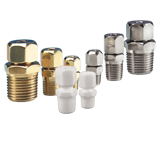Pt100 Sensor (PRT) with Lemo Connector
Rigid Stem Resistance Thermometers - Pt100 Sensors
- This style of RTD Pt100 (PRT) sensor is ideal for rigid stem applications or where the sensor is shorter than 50mm. They are suitable for many applications and are rated to 250°C
- Custom built to your specification and terminated in a Size 1 Lemo plug or socket
- Alternatively, we have a large range of sensors available to buy online in various diameters and lengths
- High accuracy, repeatability and reproducibility as simplex, duplex or triplex element assemblies
- Wide operating temperature range of -75ºC to +250ºC
- Available in 2, 3 and 4 wire configurations, in grade B, A, 1/3, 1/5 or 1/10 accuracy
- 316L Stainless Steel sheathed and manufactured to IEC 60751
Frequently Asked Questions
- What is an RTD Pt100 sensor, and how does it work?
An RTD (Resistance Temperature Detector) Pt100 sensor measures temperature by detecting changes in electrical resistance. The "Pt" stands for platinum, the material used in the sensing element, and "100" refers to the resistance value of 100 ohms at 0°C. As the temperature changes, the resistance of the platinum element varies, allowing for accurate temperature measurements.
- How accurate are RTD Pt100 sensors?
RTD Pt100 sensors offer high accuracy and stability, with industrial-grade elements ranging from Class B (±0.3ºC at 0ºC) to Class A (±0.15ºC at 0ºC). Higher precision options, such as 1/10 class elements, provide an accuracy of ±0.03ºC at 0ºC. These sensors are widely used in industrial, laboratory, and scientific applications requiring high precision. Additionally, we offer calibration services in our UKAS accredited laboratory.
- What is the temperature range for RTD Pt100 sensors?
The temperature range of an RTD sensor depends on factors such as the construction, sheath material and insulation used in the construction. While some platinum elements can withstand temperatures up to 850°C, the overall sensor design will limit the maximum temperature rating. Please check the product specifications for the exact temperature range based on the sensor’s construction. If you need any advice, our engineers are happy to assist!


 France
France Germany
Germany Spain
Spain Netherlands
Netherlands Italy
Italy Hungary
Hungary United States
United States Australia
Australia
